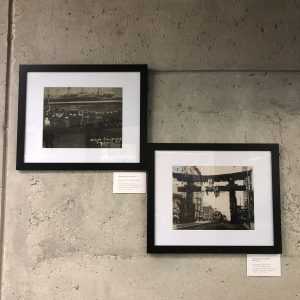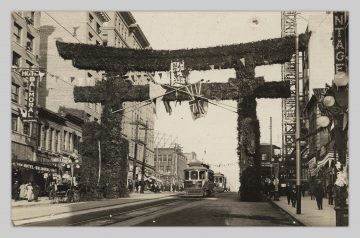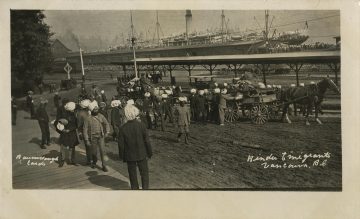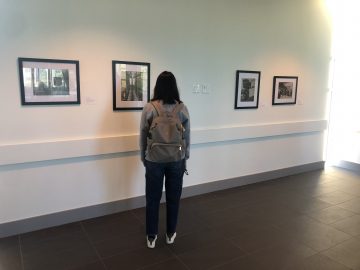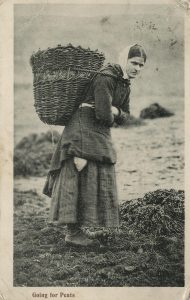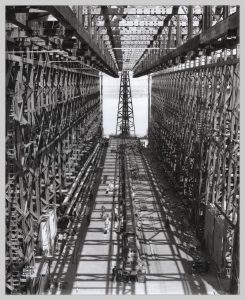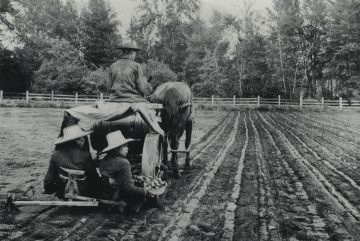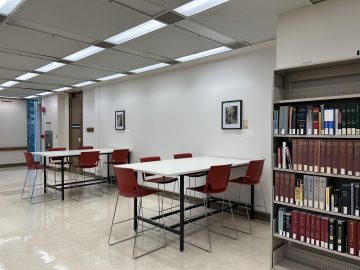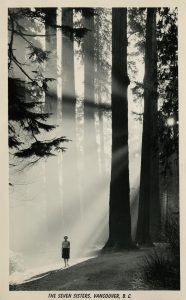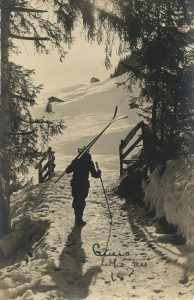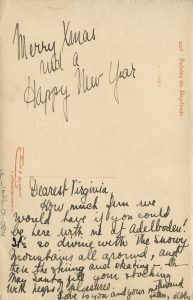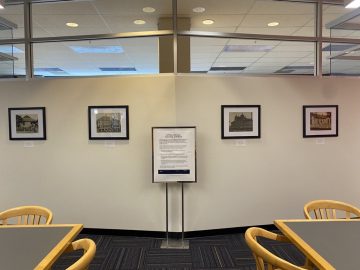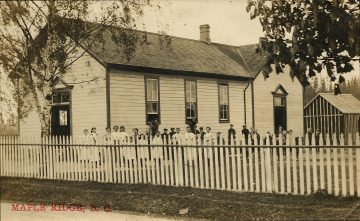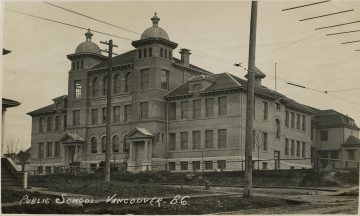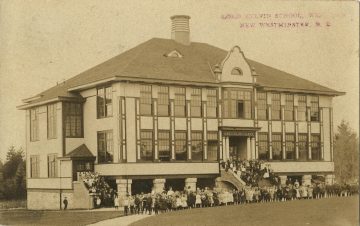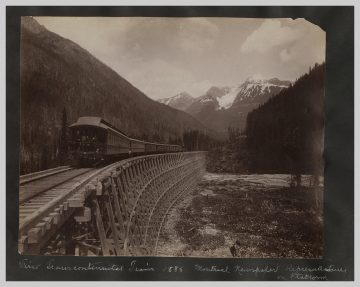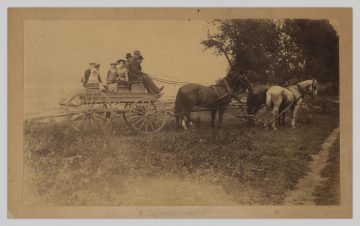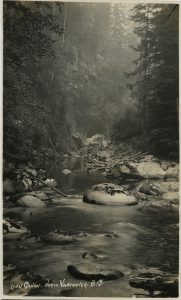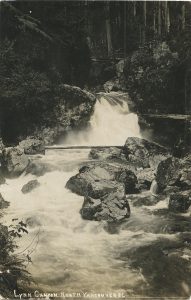Thanks to Krisztina Laszlo, an archivist with Rare Books and Special Collections for coordinating this exhibition and contributing this blog post!
Rare Books and Special Collections (RBSC) is excited to announce a collaborative exhibition of photographs from the Uno Langmann Family Collection of British Columbia Photographs on display across UBC Library branches during the 2023 Fall term. Participating are the Asian Library, Woodward Library, David Lam Library, Koerner Library, Education Library, and the Law Library. The collection, donated by Uno and Dianne Langmann and Uno Langmann Limited, consists of more than 20,000 rare and unique early photographs from the 1850s to the 1970s. It is considered the premiere private collection of early provincial photos, and an important illustrated history of early photographic methods. Like much of the library and archival materials housed at RBSC, the Langmann photographs reflect the history of British Columbia, including its history of colonisation, patriarchy, homophobia, heteronormativity, and racism. These threads are interwoven through the collection, although at the time of creation the photographers meant to celebrate and document the province’s development. A contemporary critical reading of the photographs informed the curation of the overall exhibit. Each library branch selected images to display by reviewing digitised content available on Open Collections, which currently has approximately 7,900 photographs from the Langmann collection digitised and available to the public. Branch curators each selected material according to their individual vision for the exhibit and the themes they wished to address. The selections show not only the breadth of possibilities for critical engagement, and the many ways this material can be used to ask questions about our collective history, but also the incredible scope of the archive itself.
In their own words….
Asian Library
We chose the images here as we felt that these represent pivotal moments for Asian Canadian communities in British Columbia.
Japanese Gate in Torii Style, Hastings St.
This image reflects a community that has been established and is thriving within the city. There are clear signifiers of Japanese culture and tradition, indicating the establishment of Japantown in the area. The image also sparks sadness. Following this era, the area witnessed the forced removal of Japanese Canadian community members resulting from the 1942 internment, and through its location in the heart of the Downtown Eastside, it subsequently transformed into a space of despair for many residents of the area. The Hotel Balmoral, a now-derelict single-room occupancy building that was condemned by the city and is slated for demolition, is depicted here as part of a bright and bustling cityscape, reminding us that since its construction in 1911-1912, the building has been in continuous use to the present day.
Sikh Immigrants, Vancouver, B.C.
This image signifies how not just individuals but communities immigrated to these shores. We see ship, train and carriage transportation and one can really feel the tremendous voyage that the individuals in the picture have already taken to arrive at the port, and the long journey still ahead of them to settle into the city and province. The image was also taken during a time when the Canadian government was actively trying to cut off immigration from those of Sikh faith as well as other Asian migrants, underscoring the resilience of those pictured here.
- Japanese Gate in Torii Style, Hastings St. [between 1850? and 1930?]. Uno Langmann Family Collection of B.C. Photographs. UL_1022_0042
- George Barrowclough. Sikh Immigrants, Vancouver, B.C. [between 1910 and 1920?]. Uno Langmann Family Collection of B.C. Photographs. UL_1624_03_0052
Koerner Library
We were interested in selecting images related to labour and workers, since this is a subject area included in the collections at Koerner Library and one that seems topical and timely. There has been much research and discussion recently about workers and jobs in relation to the pandemic, and at the time we were making our selections, union negotiations and strikes were very much in the news. We hope that our specific selections depict a few compelling examples of the breadth of work and industry that has been part of our provincial history, and the workers themselves who have done the labour.
- Going for Peat. c. 1900. Uno Langmann Family Collection of B.C. Photographs. UL_1626_01_0116
- Dominion Photo Co. Ship Building Facility. c.1930. Uno Langmann Family Collection of B.C. Photographs. UL_1604_0167
- Tobacco Farming. c.1915. Uno Langmann Family Collection of B.C. Photographs. UL_1626_01_0199
- Indigenous Women Working with Fishing Nets. c.1920. Uno Langmann Family Collection of B.C. Photographs. UL_1626_01_0199
Woodward Library
The Seven Sisters
A sacred place. What do these words mean to you?
At one time these trees were the most popular destination in Stanley Park for settlers and other visitors. A trail, created to allow for more visitors, was named Cathedral Trail to acknowledge the experience of standing among these giants of the forest. There was a sense of sacredness, as if standing in a great cathedral.
Too many visitors led to damaged roots, and in the 1950s the unstable trees were felled. New trees now grow in their place, but it remains to be seen if that sacred quality will ever return.
“Guess who this is?”
Libby’s postcard to Virginia from the skiing village of Adelboden, Switzerland teases us with unanswered questions. We see an intrepid adventurer beginning the long hike up to the ski area.
Who is this person?
Is it Libby, her image transposed onto a postcard with the modern equipment of the 1950s? Or a stranger, intended to represent Libby and her adventures at Adelboden? Could it be an acquaintance, known to both Libby and Virginia?
The person seems to be setting out alone, fresh and ready for the long climb ahead – there were no chairlifts in those days. But who is taking the picture?
- The Seven Sisters. c.1940. Uno Langmann Family Collection of B.C. Photographs. UL_1624_02_0110
- Thor E. Gyger. “Guess who this is?” c.1950. Uno Langmann Family Collection of B.C. Photographs. UL_1626_01_0814
- “Guess who this is?” (verso)
Education Library
Critical Literacy, Learning, and Place:
The Langmann photographs on display at the Education Library were selected to invite a critically literate approach to exploration of the images and how these relate to the history of education in British Columbia. These images, depicting schools and classes in BC between what is estimated to be between 1904 and 1930, invite questions about the intersection of place, time, and learning:
- Who were the teachers and students in the classrooms during this time period?
- Who was not included in these places of learning?
- What kinds of lessons, both explicitly and implicitly, were being taught in these classrooms? How were they being taught?
- What impact did these physical spaces have on the learning that took place within them? What lessons can we learn today about the way that place impacts learning?
We encourage visitors of the Education Library to consider these questions and more as they explore the photographs.
- William T. Cooksley. School House, Maple Ridge. c.1910. Uno Langmann Family Collection of B.C. Photographs. UL_1624_04_0043
- Public School, Vancouver. c.1915. Uno Langmann Family Collection of B.C. Photographs. UL_1624_04_0240
- Queen’s Academy, Victoria. c.1905. Uno Langmann Family Collection of B.C. Photographs. UL_1624_03_0299
- William Brown. Lord Melvin School, New Westminster. c.1905. Uno Langmann Family Collection of B.C. Photographs. UL_1624_03_0210
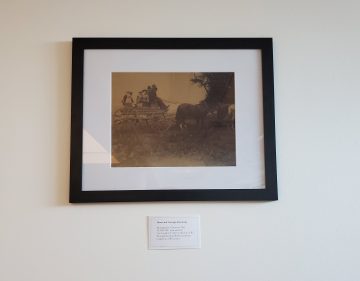
The Langmann exhibit photos are outside room 205, in the back left corner of the first floor of the David Lam library
David Lam Library
First Trans-Continental Train
I chose this image as the transcontinental railway was part of the first infrastructure to unite the east and west of Canada – a monumental point in Canadian history in 1885.
Horse and Carriage, Kamloops
This was a public bus in the 19th century. I chose this image to show what public transit was like in BC before the advent of the internal combustion engine – this is the Kamloops to Hope stagecoach line using a four horsepower locomotion: the Barnard Stage in 1885.
- First Trans-Continental Train. 1885. Uno Langmann Family Collection of B.C. Photographs. UL_1475_0014
- Horse and Carriage, Kamloops. 1885. Uno Langmann Family Collection of B.C. Photographs. UL_2050_0001
Law Library
We selected the two photos of Lynn Canyon because of the serene natural setting. Both photos provide a perfect parallel to the natural beauty of Pacific Spirit Regional Park that surrounds the UBC Vancouver campus. In addition, the north side of the UBC Law Library provides exceptional views of the North Shore where Lynn Canyon is situated.
- Lynn Canyon, North Vancouver. c.1915. Uno Langmann Family Collection of B.C. Photographs. UL_1624_04_0204
- George Gordon Nye. Lynn Canyon, North Vancouver. c.1910. Uno Langmann Family Collection of B.C. Photographs. UL_1624_04_0392
Acknowledgements
This endeavour was truly a group-effort! Thank you to everyone who helped make this multi-branch exhibit possible: Elizabeth Stevenson (Woodward Library), Sally Taylor (Woodward Library), Jacky Lai (Rare Books and Special Collections), Weiyan Yan (Rare Books and Special Collections), Jennifer Orme (David Lam Library), Christina Sylka (David Lam Library), Irena Trebic (David Lam Library), Anne Olsen (Koerner Library), Alex Alisauskas (Koerner Library), Elizabeth Robertson (Co-op Student, Koerner Library), George Tsiakos (Law Library), the team at the Asian Library, Jennifer Fairchild Simms (Education Library), Emily Fornwald (Education Library).
It’s been a pleasure working with all of you.
Krisztina Laszlo, Rare Books and Special Collections Archivist and Project Coordinator
